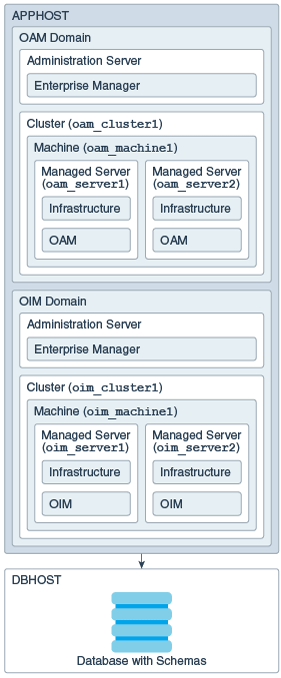1 About the Oracle Identity and Access Management Installation
Oracle Identity and Access Management 12c (12.2.1.4.0) suite has two components: Oracle Access Management (OAM) and Oracle Identity Governance (OIG).
Note:
The product Oracle Identity Manager is referred to as Oracle Identity Manager (OIM) and Oracle Identity Governance (OIG) interchangeably in the guide.
- About Supported Installation Methods
Oracle Identity and Access Management supports two methods of installation — Simplified and Traditional. - Using the Standard Installation Topology as a Starting Point
The standard installation topology is a flexible topology that you can use as a starting point in production environments.
About Supported Installation Methods
Oracle Identity and Access Management supports two methods of installation — Simplified and Traditional.
- Simplified method: by using an quick start installer to install all the products in one go.
Note:
Oracle Access Management does not support simplified method. - Traditional method: by individually installing the required products.
The following table shows the supported methods for installing and configuring the components of Oracle Identity and Access Management:
Table 1-1 Methods of Installation for Oracle Identity and Access Management
| Component | Simplified Install Method | Traditional Install Method |
|---|---|---|
| N/A | Supported? | Supported? |
|
Oracle Access Management |
No |
Yes |
|
Oracle Identity Governance |
Yes |
Yes |
Using the Standard Installation Topology as a Starting Point
The standard installation topology is a flexible topology that you can use as a starting point in production environments.
The information in this guide helps you to create a standard installation topology for Oracle Identity and Access Management. If required, you can later extend the standard installation topology to create a secure and highly available production environment, see Next Steps After Configuring the Domain.
The standard installation topology represents a sample topology for this product. It is not the only topology that this product supports. See About the Standard Installation Topology in Planning an Installation of Oracle Fusion Middleware.
- About the Oracle Identity and Access Management Standard Installation Topology
This topology represents a standard WebLogic Server domain that contains an Administration Server and one or more clusters containing one or more Managed Servers. - About Elements in the Standard Installation Topology Illustration
The standard installation topology typically includes common elements.
About the Oracle Identity and Access Management Standard Installation Topology
This topology represents a standard WebLogic Server domain that contains an Administration Server and one or more clusters containing one or more Managed Servers.
The following figure shows the standard installation topology for Oracle Identity and Access Management.
See Table 1-2 for information on elements of this topology.
Figure 1-1 Standard Topology for Oracle Identity and Access Management

Description of "Figure 1-1 Standard Topology for Oracle Identity and Access Management"
For Oracle Access Management configuration instructions, see Configuring the Oracle Access Management Domain.
For Oracle Identity Governance configuration instructions, see Configuring the Oracle Identity Governance Domain.
About Elements in the Standard Installation Topology Illustration
The standard installation topology typically includes common elements.
The following table describes all elements of the topology illustration:
Table 1-2 Description of Elements in Standard Installation Topologies
| Element | Description and Links to Related Documentation |
|---|---|
| APPHOST | A standard term used in Oracle documentation to refer to the machine that hosts the application tier. |
| DBHOST | A standard term used in Oracle documentation to refer to the machine that hosts the database. |
| WebLogic Domain | A logically related group of Java components (in this case, the Administration Server, Managed Servers, and other related software components).
See What Is an Oracle WebLogic Server Domain? in Understanding Oracle Fusion Middleware. |
| Administration Server | Central control entity of a WebLogic domain. It maintains configuration objects for that domain and distributes configuration changes to Managed Servers.
See What Is the Administration Server? in Understanding Oracle Fusion Middleware. |
| Enterprise Manager | The Oracle Enterprise Manager Fusion Middleware Control is a primary tool used to manage a domain.
See Oracle Enterprise Manager Fusion Middleware Control in Understanding Oracle Fusion Middleware. |
| Cluster | A collection of multiple WebLogic Server instances running simultaneously and working together.
See Overview of Managed Servers and Managed Server Clusters in Understanding Oracle Fusion Middleware. |
| Machine | A logical representation of the computer that hosts one or more WebLogic Server instances (servers). Machines are also the logical glue between the Managed Servers and the Node Manager. In order to start or stop the Managed Servers using the Node Manager, associate the Managed Servers with a machine. |
| Managed Server | A host for your applications, application components, web services, and their associated resources.
See Overview of Managed Servers and Managed Server Clusters in Understanding Oracle Fusion Middleware. |
| Infrastructure | A collection of services that include the following:
|